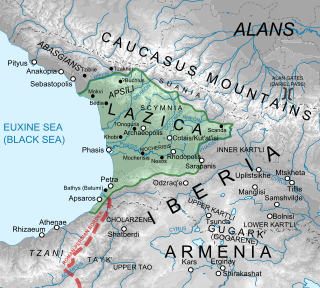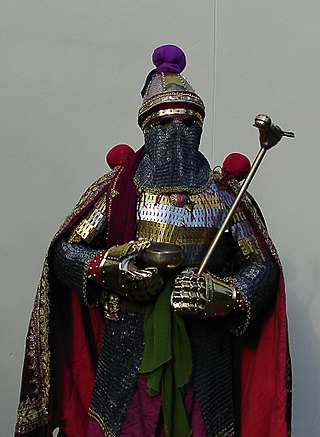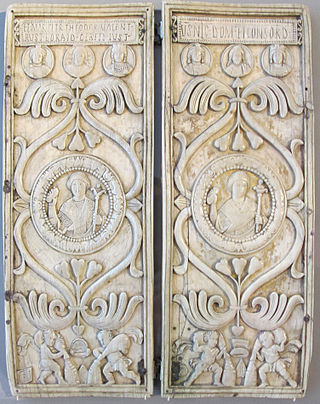Related Research Articles

Khosrow I, traditionally known by his epithet of Anushirvan, was the Sasanian King of Kings of Iran from 531 to 579. He was the son and successor of Kavad I.

Lazica was the kingdom in the territory of west Georgia in the Roman/Byzantine period, from about the 1st century BC. Created as a result of the collapse of the kingdom of Colchis and the gaining of independence by the tribal-territorial units included in it in 131 ad.

The Lazic War, also known as the Colchidian War or in Georgian historiography as the Great War of Egrisi was fought between the Byzantine Empire and the Sasanian Empire for control of the ancient Georgian region of Lazica. The Lazic War lasted for twenty years, from 541 to 562, with varying success and ended with the Fifty-Year Peace Treaty which obligated the Byzantine Empire to pay tribute to Persia each year for the recognition of Lazica as a Byzantine vassal state by Persians. The Lazic War is narrated in detail in the works of Procopius of Caesarea and Agathias.

Spāhbed is a Middle Persian title meaning "army chief" used chiefly in the Sasanian Empire. Originally there was a single spāhbed, called the Ērān-spāhbed, who functioned as the generalissimo of the Sasanian army. From the time of Khosrow I on, the office was split in four, with a spāhbed for each of the cardinal directions. After the Muslim conquest of Persia, the spāhbed of the East managed to retain his authority over the inaccessible mountainous region of Tabaristan on the southern shore of the Caspian Sea, where the title, often in its Islamic form ispahbadh, survived as a regnal title until the Mongol conquests of the 13th century. An equivalent title of Persian origin, ispahsālār or sipahsālār, gained great currency across the Muslim world in the 10th–15th centuries.
The Roman–Persian Wars, also known as the Roman–Iranian Wars, were a series of conflicts between states of the Greco-Roman world and two successive Iranian empires: the Parthian and the Sasanian. Battles between the Parthian Empire and the Roman Republic began in 54 BC; wars began under the late Republic, and continued through the Roman and Sasanian empires. A plethora of vassal kingdoms and allied nomadic nations in the form of buffer states and proxies also played a role. The wars were ended by the early Muslim conquests, which led to the fall of the Sasanian Empire and huge territorial losses for the Byzantine Empire, shortly after the end of the last war between them.

The Iberian War was fought from 526 to 532 between the Byzantine Empire and the Sasanian Empire over the eastern Georgian kingdom of Iberia—a Sasanian client state that defected to the Byzantines. Conflict erupted among tensions over tribute and the spice trade.

The SasanianEmpire or Sassanid Empire, also known as the Second Persian Empire or Neo-Persian Empire, was the last Iranian empire before the early Muslim conquests of the 7th–8th centuries AD. Named after the House of Sasan, it endured for over four centuries, from 224 to 651 AD, making it the second longest-lived Persian imperial dynasty, after the Arsacids. The Sasanian Empire succeeded the Parthian Empire, and re-established the Persians as a major power in late antiquity alongside its neighbouring arch-rival, the Roman Empire. The empire ended with the Arab conquest of Iran.

Flavius Mar. Petrus Theodorus Valentinus Rusticius Boraides Germanus Iustinus, simply and commonly known as Justin, was an Eastern Roman aristocrat and general. A member of the Justinian Dynasty and nephew of Emperor Justinian I, he was appointed as one of the last Roman consuls in 540, before going on to assume senior military commands in the Balkans and in Lazica. He fought against the Slavs, the Sassanid Persians and supervised the Byzantine Empire's first contacts with the Avars. At the time of Justinian's death, he was seen as a probable successor, but was beaten to the throne by his cousin, Justin II, who exiled him to Egypt, where he was murdered.
Mihr-Mihroe, in Middle Persian either Mihr-Mihrōē or Mihrmāh-rōy; in Byzantine sources Mermeroes, was a 6th-century Sasanian general, and one of the leading commanders of the Byzantine–Sassanid Wars of the time.

The siege of Phasis took place in 555–556 during the Lazic War between the Byzantine and Sasanian Empires. Expecting an easy victory, the Persians besieged the town of Phasis in Lazica, held by the Byzantines, but were defeated in the ensuing irregular battle. The main source for the siege is the 6th-century historian Agathias.
Bessas was an Eastern Roman general of Gothic origin from Thrace, primarily known for his career in the wars of Justinian I. He distinguished himself against the Sassanid Persians in the Iberian War and under the command of Belisarius in the Gothic War, but after Belisarius' departure from Italy he failed to confront the resurgent Goths and was largely responsible for the loss of Rome in 546. Returning east in disgrace, despite his advanced age he was appointed as commander in the Lazic War. There he redeemed himself with the recapture of Petra, but his subsequent idleness led Justinian to dismiss him and exile him to Abasgia.

Arbāyistān or Beth Arabaye was a Sasanian province in Late Antiquity. Due to its situation and its road systems, the province was a source of income from commercial traffic, as well as a constant area of contention during the Roman–Persian Wars.

Izadgushasp, known in Byzantine sources as Isdigousnas Zikh, was an Iranian nobleman from the House of Mihran, who served as one of Khosrow I's viziers.
Fariburz, known in Byzantine sources as Phabrizus, was a 6th-century Iranian military officer from the Mihran family, who served under the Sasanian king Khosrau I.

The Battle of Thannuris (Tannuris) (or Battle of Mindouos) was fought between the forces of the Eastern Roman Empire under Belisarius and the Persian Sasanian Empire under Xerxes in summer 528, near Dara in northern Mesopotamia.
Naved, Nabed, Nahbed, Nabedes, or Nobades was a Sasanian military commander during the reign of Khosrow I.
The assault on Telephis and Ollaria occurred in 553 during the Lazic War between the Sasanian Empire and the Byzantine Empire.
The siege of Petra took place in 541 when the Sasanian Empire, under King of Kings Khosrow I, besieged the town of Petra in Lazica, held by the Eastern Roman (Byzantine) Empire. The Sasanians successfully captured the fortress.
The siege of Petra was fought in 550 AD, between the Byzantines under general Bessas, and the Sasanian Persian garrison of Petra in the buffer state of Lazica. The strategic fortress had previously been held by the Byzantines before it was seized in 541 by the Sasanian king Khosrow I, and his Lazi allies. This conquest gave the Sassanian Empire access to the Black Sea and marked the beginning of the Lazic War. After a failed attempt to recapture Petra in 549, the Byzantine emperor Justinian I sent an army under Bessas to retake the fortress. The Byzantine historian Procopius described the resulting siege in vivid detail.
The siege of Onoguris occurred in 554 or 555 AD during the Lazic War between the Byzantine Empire and the Sasanian Empire.
References
- ↑ Martindale, J. R. (1992). The Prosopography of the Later Roman Empire 2 Part Set: Volume 3, AD 527-641. Cambridge University Press. p. 846. ISBN 978-0-521-20160-5.
- ↑ Rawlinson, George (2018). The Greatest Empires & Civilizations of the Ancient East: Egypt, Babylon, The Kings of Israel and Judah, Assyria, Media, Chaldea, Persia, Parthia & Sasanian Empire. e-artnow. ISBN 978-80-272-4425-6.
- ↑ Dodgeon, Michael H.; Lieu, Samuel N. C. (1991). The Roman Eastern Frontier and the Persian Wars Ad 363-628. Psychology Press. p. 121. ISBN 978-0-415-46530-4.
- ↑ Chaumont, M. L. (28 July 2011). "AGATHIAS". Encyclopaedia Iranica . Retrieved 5 March 2020.
- ↑ Ferdinand Justi, Iranisches Namenbuch, 1895, Marburg, page 219b.
- ↑ Ciancaglini, Claudia A. (2008). Iranian Loanwords in Syriac. Dr. Ludwig Reichert Verlag. p. 215. ISBN 978-3-89500-624-1.